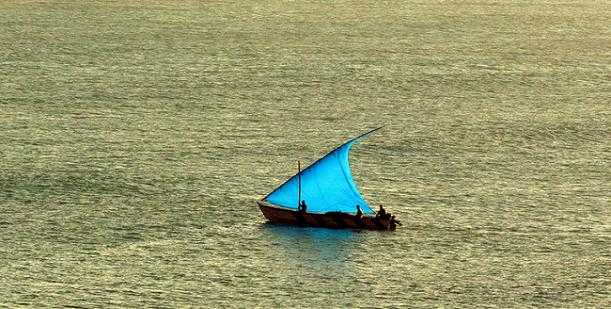I’ve often heard the question – “Are you a beach person or a hills person?” and wondered if it’s possible to be both. I love the hills – the crispness of the air, the pine scent, a slightly haunted feel after 7 pm, and the atmosphere pregnant with mystery – I love it all. I always thought beaches and oceans were not really my deal, they were too open. There is a sense of being exposed (no pun intended here) at a beach – as if every single bare truth about you is out there in the open for everyone to see. Another thing that bothered me was that there was always activity – the waves would rise, they would come close to me, wet my feet, become tiny ripples and recede. There was a soapy white disturbance on the surface all the time. But little did I know that my attitude towards the sea would change drastically after one particular visit.
After moving to Tuticorin, in Tamil Nadu for a few months, it seemed like the only thing to do was to travel out of town during weekends. Fortunately for us, Tamil Nadu is truly blessed when it comes to historical extravaganza, and pristine beaches. One casual conversation with the manager of the hotel we were staying at introduced me to Manapad. I hadn’t heard of this little village before, not surprisingly, considering I was a city-bred brat with hardly any knowledge of the region I was born in except that Mahabalipuram was somewhere close to Chennai, and Pondicherry was once a French colony.
The name sounded strange and exotic to me, and I’m a sucker for places that have interesting sounding names. When I searched the web for information on Manapad, there wasn’t really too much except the mention of its geographical coordinates and that it was home to the Holy Cross Shrine. Perhaps this was as much as I would get to know about this fishing village before I actually made the trip. Manapad lies tucked away 60 km south of Tuticorin, and around 200 km south of Madurai. If you’ve heard of the famous Murugan Temple at Tiruchendur, and have been there, you’ll be pleased to know Manapad is just 20 km away.
So we drove off one hot Saturday morning in search of what sounded like a perfect getaway for the day. While the distance to Manapad not much, one trip on the state highway dotted with potholes, that takes you there via Tiruchendur will reveal why the journey takes two hours from Tuticorin.The journey in itself was a lesson in Geography to me about so many little towns and villages that have historical or spiritual significance. I had no idea that there was a village on the eastern coast of India called Kayalpatnam until we passed it. The neat row houses on either side of the narrow streets, with water splashed near the entrance to cool the earth, the old Muslim ladies immaculately dressed in their evening clothes sitting on the porch with their tea, tiny shops selling everything from rice to balloons – these things transported me to another world. While we had tea at a make-shift stall on one of the streets, the vendor asked me if I knew that Kayalpatnam was mentioned in the Travels of Marco Polo. I just stared at him blankly, partly ashamed at my surprise that he knew about Marco Polo, and partly intrigued. He seemed to have guessed how I felt, because he added with a toothy grin, “I’ve studied History during my Bachelors.”
He told us that Kayal, as locals fondly call it, was a very important port, and was visited by the Greeks, Romans and other travelers.
After that lesson in History, we were off again, heading towards Manapad. Once we took the turn after Tiruchendur in the direction of our destination, I was filled with eager anticipation. My first glimpse of the sea as we drove into the village was through the gaps between the houses of the fisher folk who lived there, and I was transfixed by the blueness of it all. On the face of it, Manapad appeared to be a typical Indian fishing village – nets being repaired, fisher men gathered outside a house playing a game of cards after lunch, little kids running across the street from one house into another.
I noticed was how everyone smiled a lot. Whether it was the exasperated smile of a young mother as she chased her little one to feed him from the steel bowl, or the toothless smile of an old woman wearing an old-fashioned sari as she waved to us, the naughty grins of the young boys who hooted as we drove past or the shy smiles of the girls who quickly disappeared once eye-contact was established – everyone looked happy. Much later I read about issues that fishing communities in Tamil Nadu face on a daily basis, and I couldn’t help being amazed at their attitude and cheery manner of taking on life.
We decided to first drive up to the Holy Cross Shrine, the church that the village is known for. Legend has it that in 1540, a Portuguese ship was caught in a horrible storm, which led to the snapping of its hind mast. The captain of the ship, in a fervent prayer, vowed to construct a Cross out of the splintered mast if they escaped alive. He did that, and today a large Cross stands outside the shrine commemorating the original. A couple of years later, St. Francis Xavier came to Manapad for missionary activity, and built a shrine with the captain’s Cross at the altar. With the completion of the Church in the 1580′s, the reverend appealed to have a relic of the True Cross (i.e. the Cross on which Jesus is believed to have been crucified) brought to Manapad, and it did arrive from Rome via Cochin in 1583. Every year, this relic is publicly displayed from September 1st to 14th.
The view of the sea from the Church is something that I can’t forget. A few strips of golden sand in the middle of the blue waters were so inviting that we were on our way in a jiffy. As we walked along the narrow sandy path, with water on both sides, it seemed surreal. On one side, there was the sea, and on the other, just beyond the water, were quaint houses, church spires and a whole world within a few kilometers’ radius. Owing to its serenity and picture-postcard views, Manapad has played host to a few filmmakers who have fallen in love with it, and shot several scenes by the sea. It is a pet destination of my favorite film director Mani Ratnam, who shot large chunks of his film ‘Kadal’ at Manapad. I was stunned by the cinematography when I saw it, but being there in the flesh was even better. Sans the touristy shacks and restaurants, the place has a tranquility that is infectious.
Once evening set in and the boats started to arrive, the mood in the village was celebratory. The day’s catch was good. In the past, there were a few instances when I’d made plans to visit exotic beaches in Thailand and other East Asian countries that always got cancelled at the last minute. After the most recent one was shelved, I had wondered why I was being denied entry to these glorious beaches. Manapad, for me was justice, finally. I also got the answer to the question I started off with. I guess, I am a beach person after all. Not in the sense of beach parties and minty cocktails, but those ripples on the surface finally made sense. When I lay down on that golden strip of sand with water all around, I felt as close as I would ever come to knowing Zen.

























thebookofA
Weekends in Tamil Nadu, Manapad and how I became a sea lover! | The WAH Travel Blog http://t.co/G6OYwO0m84 via @weareholidays
ThakurRajesh
Weekends in Tamil Nadu, #Manapad and how I became a sea lover! http://t.co/rcVeqLZJXT #placeswelove
WeAreHolidays
*New on the blog* Weekends in Tamil Nadu and how I became a sea lover > http://t.co/cRjp1JrIbx Say hello to our newest contributor @Nan_35
I would prefer hills any day!
Brilliant! great pictures and very educative and enjoyable narration. Wonder how or why in my 21 years of stay in Chennai i never heard anything about Manapad. Now will keep my antennas alert not only for Manapad for that Church but also for Kayalpatnam to wander and see what u saw. Thanks for enlightening about this weekend gateaway.